Content
- Types of congenital torticollis in a child, causes of development and signs
- Congenital
- Acquired
- Myogenic (spastic)
- Bone and articular
- Neurogenic (neurological)
- Compensatory
- Installation
- What is false torticollis?
- Risk factors
- Complications and consequences
- Strabismus due to torticollis
- Diagnosis of torticollis in a newborn
- Treatment methods
- Massage
- Rehabilitation gymnastics
- Surgery for crankshaft
- Treatment of spastic torticollis
- How to choose a pillow for a baby with a crooked neck?
- Is electrophoresis done for torticollis?
- Video about torticollis in newborns
Torticollis is a congenital anatomical anomaly characterized by tilted head position with a turn in the opposite direction. Pathology characteristic of infants. Its presence can be determined by external manifestations and symptoms.
Types of congenital torticollis in a child, causes of development and signs
Diseases are classified into many different types depending on the causes of the abnormality in the development of the cervical spine or various muscle groups.
Factors contributing to the development of torticollis:
- deforming changes in the region of the vertebrae, which led to a violation of the structure of the spine;
- abnormalities in the development of the mastoid muscle group;
- injury to muscle fibers during childbirth;
- improper placement of the fetus in the womb, resulting in unilateral pressure of the uterus.
Also, a violation can occur against the background of various internal diseases developing in the neck.
Congenital
This form of pathology is associated with damage to receptors located in the neuromuscular system. In this case, there is a decrease or increase in muscle tone. The disease can be caused by various injuries in the cervical spine received during childbirth.
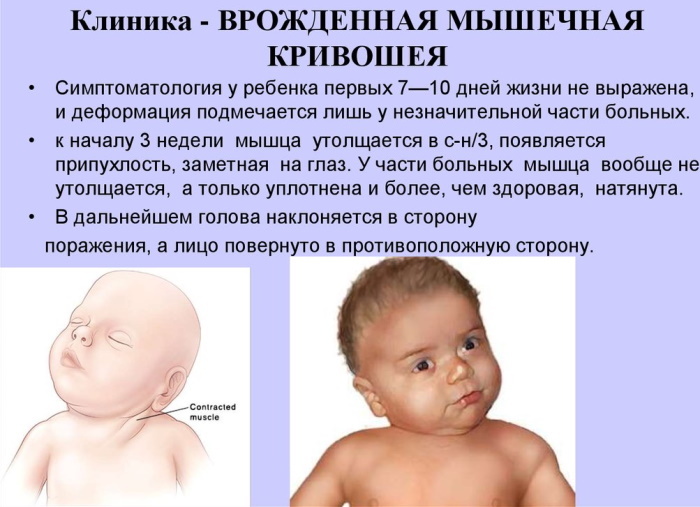 Violation can occur as a result of infectious diseases in the perinatal period or against the background of hypoxia.
Violation can occur as a result of infectious diseases in the perinatal period or against the background of hypoxia.
Acquired
The acquired type of pathology can occur for various internal reasons - neoplasms in the central nervous system, against the background of cerebral palsy, as a result of previous polio.
Myogenic (spastic)
The provoking factors for the development of this type of disease are laid even in the prenatal period. The pathology is characterized by underdevelopment of the sternocleidomastoid muscle.
The reasons for the shortening of the neck:
- incorrect and prolonged position of the fetal head inside the womb;
- insufficient blood supply;
- poor load on the muscle.
When passing through the birth canal, the muscle is injured, its tear occurs or hemorrhagic processes are formed, against which inflammatory diseases develop.
Bone and articular
This type of disorder occurs when the first cervical vertebra is injured (fractured). Pathology is characterized by pain when touching or moving the head.
Neurogenic (neurological)
This type of disease is characterized by a decrease in muscle tone on the one hand and an increase on the other. The disease has a second name "dystonic syndrome".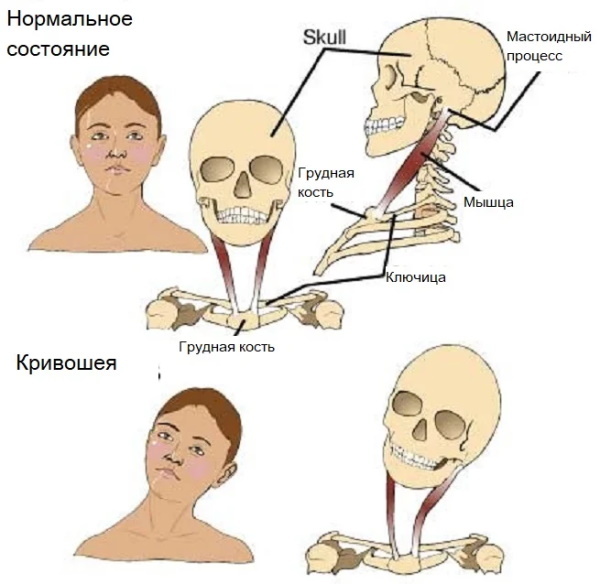
The provoking factors for the occurrence are various infectious processes that affect the nervous system.
External signs:
- head tilt to one side;
- bent leg;
- clenched hand.
Moreover, such defects are observed only on one side. When lying on the stomach, the spine resembles an arc. However, there are no problems with neck rotation.
Compensatory
Torticollis in infants (symptoms of the disease can be varied and determined individually) can develop according to the principle of compensation.
The compensatory type of pathology occurs against the background of other internal diseases. The disease develops as a defense mechanism in response to disorders that have arisen in the field of the organs of vision and hearing.
Diseases provoking the development of a compensatory form of impairment:
- hearing problems (hearing loss);
- complete or partial blindness of one eye;
- the presence of cataracts;
- diseases of the vestibular apparatus.
The newborn can tilt the head and rotate the neck to adjust vision or hearing, and to avoid accidental falls or dizziness.
Installation
The main reason for the development of this type of disorder is the child's prolonged stay in one position. Perhaps this is when the baby does not change body position during sleep or while feeding.
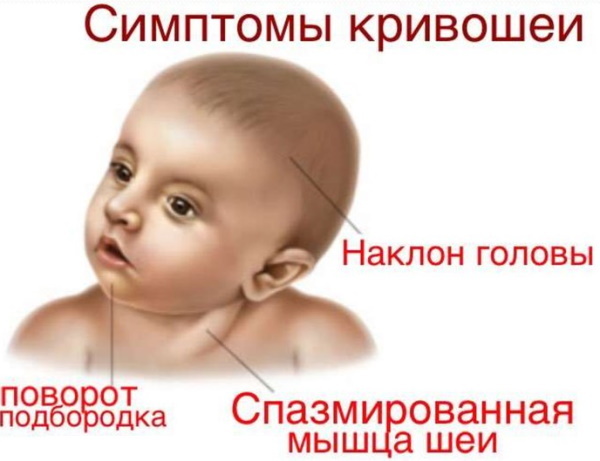
With the disease, signs of damage to muscle tissue and spine, as a rule, are absent.
What is false torticollis?
The false form of the disease develops due to the increased tone of the sternocleidomastoid muscle. At the same time, all signs of the disease are observed in newborns, however, treatment is not required, since the violation goes away on its own or is corrected with the help of various exercises and massage. The disease manifests itself in children quite often.
Risk factors
Torticollis in infants (symptoms of the disease can be both pronounced and almost imperceptible) can develop as a result of existing disorders in a pregnant woman.
Expectant mothers should take into account that there are certain risk factors that can lead to the development of a pathological process in a child.
Possible factors:
- Poor posture or scoliosis in the mother. With the development of the disease, the internal organs are displaced, which is the basis for the asymmetric arrangement of the fetus.
- Presentation of the buttocks. Improper placement of the fetus in the uterine cavity can lead to underdevelopment of muscle tissue.
- Heavy pregnancy. Complications while carrying a child can lead to various disorders, including the development of torticollis.
- Umbilical cord entanglement can also cause various birth defects and diseases, since with such a violation, the transfer of nutrients and oxygen is impaired.
- Injury during childbirth. During the passage through the birth canal, the child can receive various injuries, which will subsequently lead to the development of torticollis.
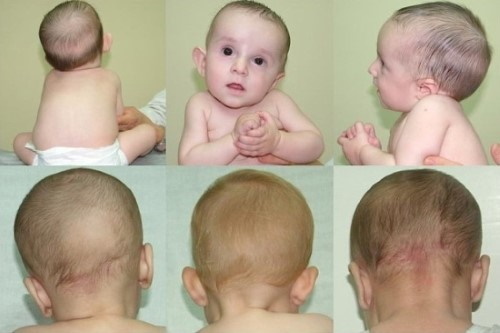
Also, a predisposing factor is a violation of the rules when taking childbirth or the inexperience of a specialist.
Complications and consequences
In the absence of timely and competent treatment, the anomaly can lead to various additional disorders.
Complications and consequences:
- asymmetric development of the cranium;
- deforming face change;
- underdevelopment;
- strabismus;
- diseases of the musculoskeletal system and the spine - kyphosis, scoliosis, osteochondrosis;
- discomfort when turning the head;
- various mental and neurological disorders.
In this case, the pathology will be determined by external signs. A person's head will always be tilted to the shoulder.
Strabismus due to torticollis
This disorder develops quite often. The provoking factor in this case is the inconsistency of the work of the eye muscles or a decrease in their tone. Strabismus and torticollis are closely related, since the muscles of the neck fix the eye muscles in an incorrect or unusual position. This leads to the fact that the muscles of the eyes are rearranged under new conditions in order to restore visual function.
When trying to consider the situation and surrounding objects that are on the opposite side, the newborn develops squint. This violation occurs almost simultaneously with the development of the pathological process.
Diagnosis of torticollis in a newborn
To make an accurate diagnosis and identify the cause of the development of pathology, a comprehensive study is carried out. First of all, a visual examination of the child is carried out, the muscles of the neck are probed. Next, they move on to instrumental diagnostic methods.
Types of examinations:
- Ultrasound of the cervical spine.
- Magnetic resonance imaging of the cervical spine (MRI).
- Doppler ultrasonography of the neck vessels.
- Neurosonography (NSG) is a study of the structure of the nervous tissue.
It may also be recommended to visit narrowly focused specialists - a neurologist, orthopedist, traumatologist, ophthalmologist.
Treatment methods
Torticollis can be eliminated using a variety of therapeutic techniques. Each of the methods is selected individually for the baby, taking into account the severity of the disorder and the severity of the symptoms.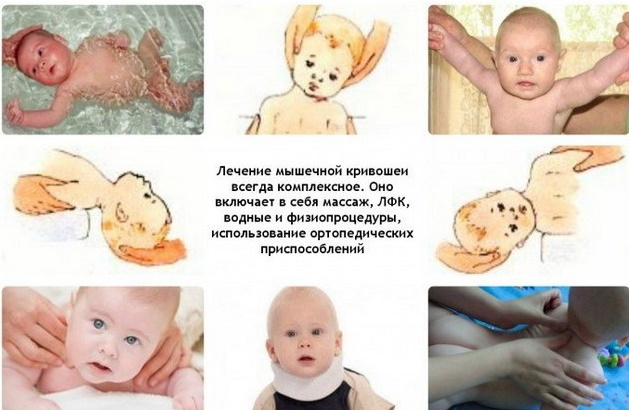
There are several main methods of treating pathology. Most of them can be done independently.
It is recommended to take training courses before performing the massage. Gymnastics should be performed strictly with the instructions of a specialist. In addition to the complex, it is recommended to undergo physiotherapy (for example, electrophoresis or UHF).
In extreme cases, surgery is prescribed.
Massage
Massage is indicated in the case of the development of a moderate severity of pathology. The procedure can be performed both on a specially prepared surface and in a warm bath.
Massage:
- Start with a warm-up. Massage the whole body with stroking movements.
- Gently knead the affected area (muscle).
- Stroke and lightly rub the healthy cheek.
- Warm up the head, alternately turning it from one side to the other.
- Knead the abdomen area with light stroking actions.
- Neck massage - first knead the damaged muscle, then from the healthy side.
- Foot massage.
- Massaging the neck and back.
- Warm-up the body - in the prone position, the child is turned from one side to the other.
- Warm up arms and legs with light stroking movements.

When performing a therapeutic massage, special attention should be paid to warm-up the neck. The healthy part should be kneaded more intensively than the damaged area. The sore muscle is massaged very gently without pressure or pressure.
In this case, the healthy area can be pinched, kneaded, tapped and rubbed.
It should be borne in mind that the procedure has some contraindications:
- torticollis, which has an acute inflammatory nature of origin;
- the presence of neoplasms (malignant and benign);
- dermatogenic form of the disease;
- internal diseases leading to damage to the skeletal system - tuberculosis, osteomyelitis.
With these restrictions, it is necessary to consult a doctor who will help you choose other methods of treatment.
Rehabilitation gymnastics
Torticollis in infants (symptoms of a disorder can be determined visually, however, the cause can only be identified with the help of instrumental types of diagnostics) requires an integrated approach to treatment, including the implementation of special medical gymnastics.
To carry out gymnastic exercises, you need 2 people. This is necessary to keep the child's body in the correct position and simultaneously rotate his head.
When performing the complex, it is necessary to monitor all movements and symmetrical body position of the newborn.
Before gymnastics, the baby should be placed on the table in such a way that his shoulders are parallel to the table at its very edge. The baby's head and neck should hang slightly.
Exercises # 1. Support the baby's head with the chin touching the chest. At the same time, they begin to gradually weaken the support, due to which the baby's head will begin to slowly sink down. During the exercise, care must be taken that the baby's head does not turn to the side.
When performing gymnastics, it is also required to ensure that the child's head does not overly tilt back. After the baby lowers its head down, it is necessary to raise it again with both hands and return it to its original position.
This exercise must be repeated 5 times.
Exercise number 2 - turn the head. Gymnastics is also performed together. One person should hold the child's body, and the other person alternately turns the child's head with both hands in different directions.
Exercise should be done at least 2 times a day. The maximum amount is 5 times a day.
Surgery for crankshaft
Surgical intervention is used only according to the indications of the attending physician and in severe cases, when therapeutic exercises and massage cannot cope with the disease.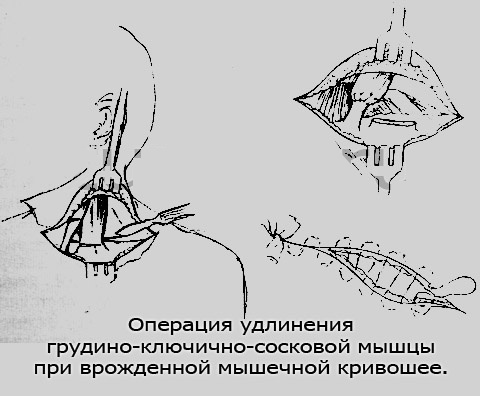
The operation is of 2 types. In the first option, the intervention is carried out when the child reaches 1 year old, when the specialist cuts the muscles.
In the second case, the operation is prescribed at the age of 4. The procedure involves plastic lengthening of the muscles.
However, after surgery, children may experience complications in the form of scar tissue formation. In this regard, constant supervision by a doctor is required.
Surgery can only be performed on children who have reached 2 weeks of age.
Treatment of spastic torticollis
Torticollis in infants (symptoms of the pathological process appear almost immediately) requires urgent treatment, which can be either conservative or alternative.
The spastic form of the disease occurs as a result of improper transmission of impulses, which leads to excessive contraction and causes the head to tilt.
Treatment of the disorder consists in taking medications.
Medicines:
- Muscle relaxants (Baclofen).
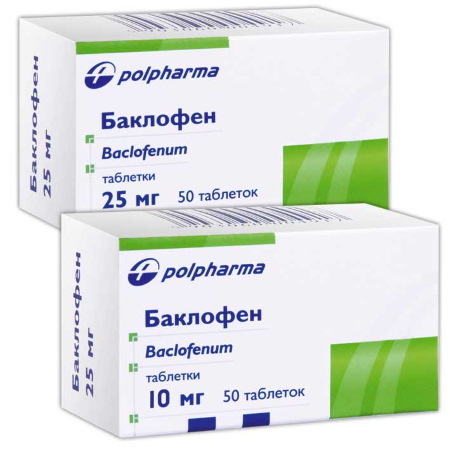
- Anti-convulsive drugs (Clonazepam).
- Antiepileptic drugs (carbamazepine).
- Anticholinergics (Cycloldol, Norakin).
The most popular and effective means of drug therapy is the injection of botulinum toxin. The action of the drug is aimed at blocking the transmission of impulses passing through the neuromuscular fibers.
The effect of the drug lasts for six months. At the end of this period of time, re-administration of the solution is required. Treatment can take several years.
With pronounced signs of the disease or in more severe cases, surgical intervention is prescribed.
Previously, to eliminate pathology, interventions were used, the actions of which were aimed at intersecting the sternocleidomastoid muscle or nerve endings located in it. However, the procedure is not used now, as it often leads to various complications.
Stereotaxic surgery is now being used. The essence of the procedure is to conduct small discharges of electric current through special electrodes. These electrodes are inserted into a hole made in the skull region, after which a discharge is applied.
The technique allows you to eliminate all signs of cervical dystonia, and also prevents the development and transmission of pathological nerve impulses.
As a supplement, various recipes from traditional medicine can be used. However, the use of such funds must be previously agreed with the attending physician.
| Ingredients | Preparation | Admission rules |
| 500 g pork fat. 100 g lilac buds |
Mix the components and boil in a water bath for 1 hour. Let the mixture cool. | Used to rub the problem area 4 times a day. |
| 0.2 g mummy 1 tbsp. pure water 1 tsp honey |
Dissolve the mummy in water and add honey. Mix everything thoroughly. | Take 1 time per day before bedtime or in the morning on an empty stomach. Duration of admission is 3-4 months. |
| 75 g linden flowers 100 g viburnum bark 100 g lavender 500 ml of water |
Take 200 g of each plant and mix thoroughly. Pour the mixture into a container, put on fire and boil for 5 minutes. let it brew for 2 tsp. | Consume 100 ml 4 times a day. Strain the mixture before use. |
Folk remedies are used only as an auxiliary treatment, since these recipes are not able to cope with the disease on their own.
How to choose a pillow for a baby with a crooked neck?
In case of crotch, it is forbidden to use ordinary feather or synthetic pillows, as this can lead to a deterioration in the child's condition.
It is recommended to purchase special orthopedic pillows. Moreover, such a pillow should have a special hole in the shape of a crescent, where the child's head is threaded.
The pillow is corrective and prevents the newborn from sleeping in one position on the affected side.
Is electrophoresis done for torticollis?
As an adjunct, electrophoresis can be prescribed. In this case, vasodilators are used. To enhance metabolic processes, agents such as iodine, lidase solution are introduced.
It is recommended to undergo procedures daily. The duration of each session is 15 minutes. The total number of procedures is from 15 to 20.
Reapplication of electrophoresis is possible after a break of 2-3 months.
At the first symptoms of the disease, you should immediately consult a doctor, since torticollis in the absence of timely therapy can lead to various complications in infants and cause severe disorders that are bad are treatable.
Video about torticollis in newborns
Torticollis in infants:



